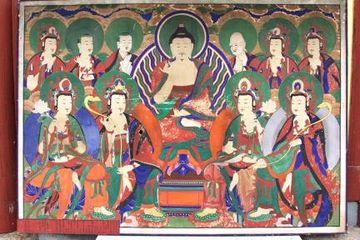고령 관음사 아미타여래도
| 고령 관음사 아미타여래도 Buddhist Painting of Gwaneumsa Temple, Goryeong (Amitabha Buddha) |
|
 고령 관음사 아미타여래도, 국가문화유산포털, 문화재청. |
|
| 대표명칭 | 고령 관음사 아미타여래도 |
|---|---|
| 영문명칭 | Buddhist Painting of Gwaneumsa Temple, Goryeong (Amitabha Buddha) |
| 주소 | 경상북도 고령군 고령읍 연조리 206 |
| 지정(등록) 종목 | 경상북도 문화재자료 제672호 |
| 지정(등록)일 | 2019년 3월 25일 |
| 분류 | 유물/불교회화/탱화/불도 |
| 수량/면적 | 1폭 |
| 웹사이트 | 고령 관음사 아미타여래도, 국가문화유산포털, 문화재청. |
|
|
|
해설문
국문
고령 관음사 아미타여래도는 화기(畵記)*를 통해 순종 2년(1908) 원일(圓日)과 진규(眞珪) 두 승려가 그린 것으로 확인되었다.
가운데의 아미타여래를 중심으로 아래쪽에는 유희좌(遊戱坐)*를 한 보살 4위가 있다. 위쪽에는 좌우로 석가모니의 제자인 가섭(迦葉)과 아난(阿難)이 있으며 그 옆으로 보살 4위가 나란히 서 있다.
불화의 구도와 보살의 자세, 채색과 인물의 표현 기법 등은 19세기 사불산화파 및 경상도 일대의 전통불화의 특징을 계승하였다.
- 화기(畵記): 그림에 쓴 시나 글
- 유희좌(遊戱坐): 한쪽 다리는 곧추세우고 다른 한쪽 다리는 대좌 아래로 내려뜨린 자세.
영문
Buddhist Painting of Gwaneumsa Temple, Goryeong (Amitabha Buddha)
This Buddhist painting depicts Amitabha, the Buddha of the Western Paradise, seated on a lotus pedestal in the center, surrounded by eight bodhisattvas and two disciples of the Sakyamuni Buddha. It was created in 1908 by the monk painters Wonil and Jingyu.
It is believed that all beings who call the name of Amitabha while reflecting on his meritorious virtues can be reborn in the Buddhist paradise of the West. The two figures depicted to either side of the Amitabha’s head are the most outstanding principal disciples of the Sakyamuni Buddha, namely Maha Kasyapa and Ananda. Next to them are four bodhisattvas, two on each side. Seated in front of the Amitabha are also four bodhisattvas, two on each side. These bodhisattvas have one foot placed on the ground and the other leg bent, hanging in the air.
The overall composition of this painting, the seated pose of the bodhisattvas, and the style of the colors follow the typical characteristics of Buddhist paintings painted in the Gyeongsang-do region in the 19th century.
영문 해설 내용
이 불화는 연화대좌 위에 앉아있는 아미타여래를 중심으로 부처의 두 제자와 여덟 보살을 함께 그렸다. 1908년 승려화가인 원일과 진규에 의해 조성되었다.
아미타불은 극락정토의 부처로, 아미타불의 공덕을 기리고 그의 이름을 염(念)하는 모든 중생들은 극락세계에 왕생할 수 있다고 여겨진다. 아미타여래의 광배 양옆에는 석가모니의 가장 뛰어난 제자인 가섭과 아난이 있고, 그 옆으로 보살이 2위씩 좌우에 대칭으로 배치되어 있다. 아미타여래의 대좌 양옆에도 보살이 2위씩 있는데, 이 보살들은 한쪽 다리는 세우고 다른 한쪽 다리는 대좌 아래로 내려뜨린 자세를 하고 있다.
이 불화의 전체적인 구도, 보살의 앉아있는 자세, 채색 기법 등은 19세기 경상도 일대에서 그려진 불화의 특징을 따랐다.
참고자료
- 고령 관음사, 아미타여래도·신중도 경북도 문화재자료 지정, 프레시안, 2019. 3. 27. https://www.pressian.com/pages/articles/234244?no=234244&utm_source=naver&utm_medium=search -> 선정 이유 (조선후기 불화의 정통성을 계승한 작품이라는 점에서 의의가 있다.)
- 사불산화파 : 19세기 경북 문경 사불산의 김룡사, 대승사를 기반으로 삼아 인근 경상도와 멀리 경기,충청 지역에서 활동했던 승려 화가 유파의 하나.(관련 논문 : 朝鮮後期 四佛山佛畵 畵派의 硏究, 김경미, 미술사학연구 236, 2002)
- 관음사는 1911년 합천 해인사의 포교당으로 창건되었으며, 1990년대에 현재 자리로 옮겨졌다. (https://blog.naver.com/gokory/221532266375)